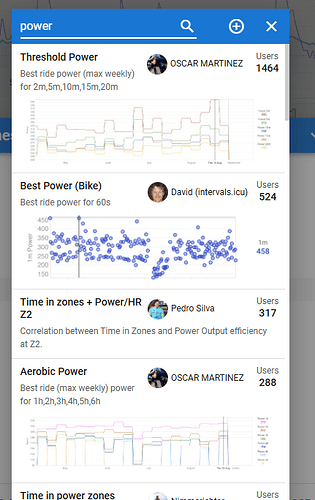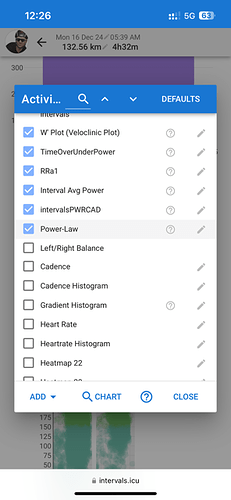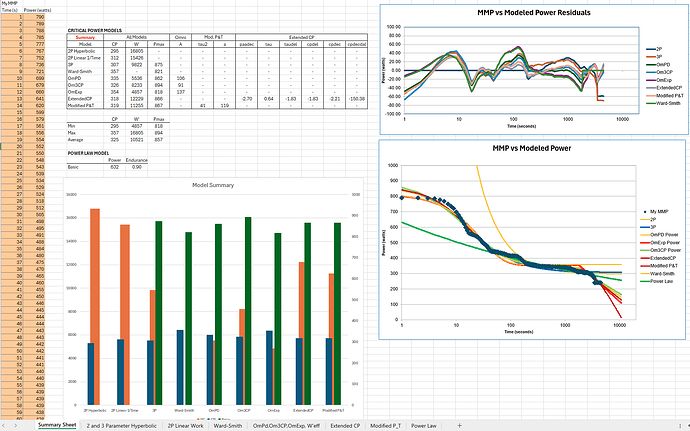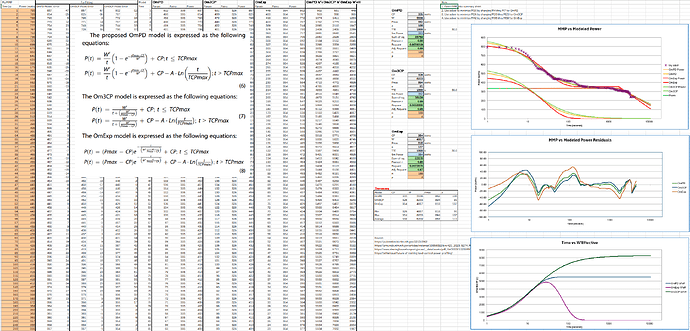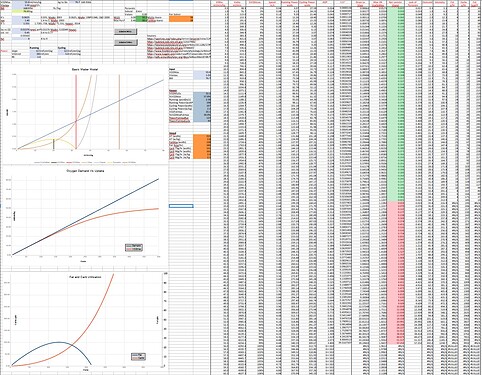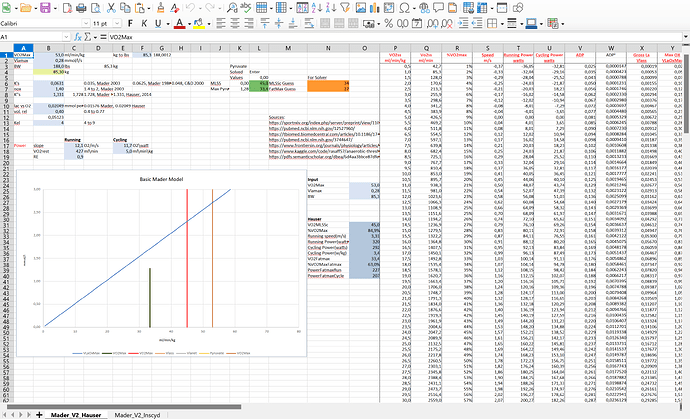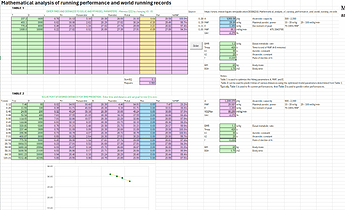I’d be interested in reading more research on pacing if you have links to any. Also, I don’t know which pacing is optimal according to the CP model.
The power-law model paper now published, perhaps something that could be implemented in Intervals.icu?:
Modelling human endurance: power laws vs critical power | SpringerLink.
Twitter/X-synopis: Axel Finke on Twitter: “Critical power vs power laws in endurance sports: A brief  1/10 https://t.co/lqJ8WfgdRe” / X
1/10 https://t.co/lqJ8WfgdRe” / X
Any news about a possible implementation of a new feature capturing the power laws?
Out of curiosity, how will you use the power law/fitting parameters for training and race planning?
Of the models I have, the power law fit is pretty bad. But it could be useful to compare fitting parameters over time, especially the “fatigue” factor.
Hi do you have any news for the implementation of the power-law fit for cycling?
These days people is forced to use excels outside any platform, and will be a real difference maker for intervals.icu.
I created this, I don’t know if it will be useful to you, let me know if you need any modifications.
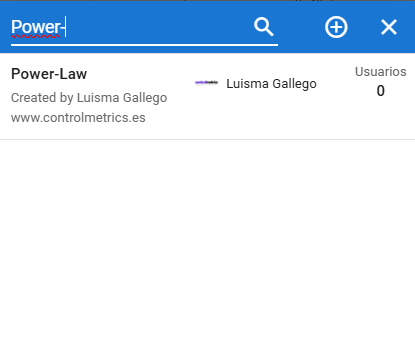
Thanks Luisma! It’s a custom chart? I can’t find it in the custom chart list. May I’m doing somthing wrong?
It’s an activity-level chart:
Open the activity, go to power tab
Scroll to bottom
Activity Charts
Type in Power-Law
Just updating an older thread…
I’m sharing a spreadsheet that has several models included to fit your mean maximal power curve and develop modeled power duration curves. Several of the models are typical models that you’ll find everywhere, such as the two and three parameter models. I also have some of the more modern models like the Omni-Domain Model, Extended Critical Power Model (found in Golden Cheetah) and a modified Perronet and Thibaut model (presumably similar to the WKO model). A power law model is also included. Hopefully these model implementations can help you estimate a value for critical power to use for training.
This spreadsheet has not been quality checked by anybody and you should presume that there could be errors somewhere in the spreadsheet. This spreadsheet has been set up for Microsoft Excel, however you probably can get it to work in LibreOffice pretty easily.
To use the spreadsheet, you’ll need to paste your mean maximal power curve into the summary sheet and then go sheet-by-sheet and use the built-in solver to come to a solution for the model fitting parameters. The sheet is set up to take the data from Intervals.icu CSV for your mean maximal curve of interest and paste directly into the sheet. Or you can use a mean max curve with up to 4,208 rows of data.
You can automate this task, but I find that going model by model and fit by fit gives you a better idea of whether your model fits are reasonable or not.
The sheet
https://1drv.ms/x/c/7aaa504c5ba71805/EXFZw3fJ5UxNrWba-L6BMiMB2qpnlin3e7cPMo2jqJFtjg?e=9jdJ9Z
Sheets:
-
Model Summary
-
2 parameter, 3 parameter – hyperbolic
-
2 parameter – linear work
-
Ward-Smith
-
Omni-Domain, Omni-3 parameter, Omni-Exponential
-
Extended CP
-
Modified Perronet & Thibault
-
Power Law
Summary sheet
OMPD sheet
More sheets and models coming…
Here’s another spreadsheet. Mader’s basic model
Its a very crude implementation the model from the 1986 paper. The sheet may have errors and I don’t have a bio/physio background, so consider this a simple numerical calculator, of sorts.
The main references are in the sheet. Hauser, 2014 and Mader, 1986.
I coded the sheet in LibreOffice Calc – it’s free and useful. There are some modifications you can make to have this in Excel (charting, VBA coding).
Input parameters
Not sure where vol. rel. comes from - if you look at Incsyd reports, Vol. rel. seems to be based on a calc using body characteristics (height, weight, body fat, etc.)
Seems K”s is adjusted based on VLaMax magnitude, high = 1.728, low = 1.331
Where to get VO2Max? – Watch estimate, ASCM formula, 5m Cycling power correlations, Software (WKO5, GC), other correlations (ramp test, Cooper test, etc.)
Where to get CP? – intervals, WKO5, GC, maybe TR (what model?). Use FTP also. Need good proxy for mlss.
How to estimate VLaMax? – Back-calculate. Use spreadsheet to iterate by varying VLaMax to find CP/FTP (mlss)
Fat and CHO correlations – I have no idea where they come from.
The sheet:
https://1drv.ms/x/c/7aaa504c5ba71805/EdeXFlTCYwZDgWGawN4E4coBsSXuAH8wK8GkM3wD5Nfaww?e=zvjNnL
A very quick video showing the basic operation:
https://1drv.ms/v/c/7aaa504c5ba71805/EQUYp1tMUKoggHq-zAAAAAABT6nWA3RvgGeVcVRNhmk6vg?e=srbfnA
A better explanation of the model can be found at the link I always share:
Thanks for sharing.
But it seems I can’t get it work. I have not these calculation buttons and I miss some graphs.
Any idea?
yep, this doen’t work. Just like the CP one
Let me find a better way to share the sheets. I believe OneDrive is the problem.
I changed the location of the sheets to a Dropbox folder and checked the downloads on a separate computer. The files should work now.
Just a quick note about the Mader sheet…make sure you modify the macro security settings for the file (if you trust it). Also, you’ll need a 64-bit JRE for goalseek.
For some reason I can’t edit my posts, so here’s the updated link:
https://www.dropbox.com/scl/fo/fjlrvq52lbz8xav2mlzz1/ABboAKaYX7gB9QEY9ifosJM?rlkey=hzqddu37dow05cyl023ij0ahn&st=pxuf9jxg&dl=0
The CP spreadsheet has been updated a bit. I just added buttons on each sheet to automate the solver function.
See the new link just above for the file.
Now it works. Amazing, many thanks
Many thanks ![]()
I added another couple workbooks to the Dropbox folder. These are focused more on running. Hope some of you find them useful.
CV Modeling V2.3.1 is basically the same model set in the critical power workbook, but you can use speed and duration to get CV and D’.
One thing to notice is how some models need a variety of data on order to get reasonable fitting parameters. The Extended CV and Modified P&T model sheets show good examples of difficult model fit when data is missing at the short and long ends of your MMP.
Running Estimates (**) V1.0 is a workbook that contains a few different sheets. One sheet is called CP,CV,VDOT Estimates and can be used for…CP/CV and Vdot estimates. Plug in some distances, times, and power to get a linear 2P estimate. The Vdot estimates are from the equations provided in Oxygen Power.
The other sheet in this workbook is the Peronnet and Thibault model. This model can be used to fit durations from a few seconds to several hours. I have a macro that will fit the test data and then estimate times for distances from 60m to 42.2km.
** = there are workbooks with some Jakob Ingebrigtsen and Eliud Kipchoge annual PR’s modeled used for examples.
i find difficult to use, i mean i need to input the data por 20min 5min etc… but have just “space” for time/power , so i onçy can put one data - or im too stupid to not understand ?
What would you like to do? I know my sheets are not very user friendly.



